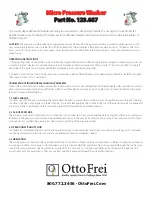
17
INSTALLATION
WALL MOUNTING
• Chose a suitable wall where the high pressure water cleaner can be mounted: the high
pressure water cleaner must be mounted exclusively on brick walls or reinforced cement
walls with thickness of no less than 10 cm/4”; do not mount the high pressure water cleaner
on walls made of plasterboard, wood, sheet metal or any other material that is not suitable
to take the wall-plugs supplied.
• To mount on the wall, use exclusively the kit supplied (bracket, screws, wall-plugs and
nuts): if any part of the kit is lost or damaged during installation, contact your dealer to
have it replaced.
• Rest the bracket (11) against the wall and trace two marks with a pencil through the holes
F (
See FIG. 1
) that will act as a reference for drilling the holes: position the frame roughly at
the height of your shoulders to ensure ease of use.
• Using a 10 mm/0.4” bit (not supplied), suitable for drilling brick/reinforced cement walls,
drill two holes, approximately 8-9 cm/3.2-3.5” in depth where the holes were marked
earlier. When drilling the holes, pay attention to the safety warnings given in the use
and maintenance manual of the drill used. Also remember to make sure no pipes and/or
electrical cables run through the wall where you drill the holes.
• Put the wall-plugs (14) in the holes, making sure their necks are
ush with the wall: do not
push the wall-plugs too far into the wall and do not leave them protruding from it either.
• Using a 5 mm/0.2”
xed jaw spanner (not supplied), screw the screws (9) until the threaded
part enters the wall-plug completely.
See FIG. 5
A.
• Put the rubber rings (10) in the safety hooks (3) and (7), and then put the hooks in the wall
bracket (11). Make sure the hook (3) is inserted on the left and the (7) on the right.
See FIG.
5
B and 5
C.
• Put the bracket (11) in the screws protruding from the wall and secure it with the nuts (16).
While doing this, make sure the screws (9) enter the hole F of the bracket and the special
slot in the hooks
• (3) and (7). Before you tighten the nuts permanently (16), using a 13 mm/0.5”
xed jaw
spanner (not supplied), make sure the hooks (3) and (7) are raised.
See FIG. 5
B and 5
C.
• Make sure the wall bracket is
tted
rmly: do not hang on the bracket with your own
weight to check it.
• Make sure the release button (8) is released, by pushing it inwards; raise the high pressure
water cleaner safely and
t the bottom guide in the bracket (11), until the button clicks
(8).
See FIG. 5
D.
• Lower the hooks (3) and (7), so that they couple in the cowling of the high pressure water
cleaner.
See FIGS. 5
E and 5
F.
• Feed the power supply cable (6) within the relative guide.
See FIG. 5
G.
• If you wish, you can also install the wall-mounted accessory frame (13), exploiting the
screws (36) and the wall-plugs (37w) supplied. To drill, use a 6 mm/0.24” bit (not supplied),
making three holes, approximately 4-5 cm/1.6-2.0” in depth by marks made as previously
described for the wall-mounted frame. Use a suitable Philips screwdriver to tighten the
screws (not supplied).
See FIG. 6.
DEMOUNTING FROM THE WALL
INSTALLING ON THE FLOOR
• Unscrew the
tting (25) and remove the
lter and gasket.
See FIG. 1.
Put the
tting away
in a safe place because it will be used again when the high pressure water cleaner is put
back on the wall.
• Put the
lter (18) in the water inlet
tting (17). Put the gasket (26) in the curved hose holder
(27) and screw it to the
tting (17).
See FIG. 1.
The installation of the curved suction
tting


































